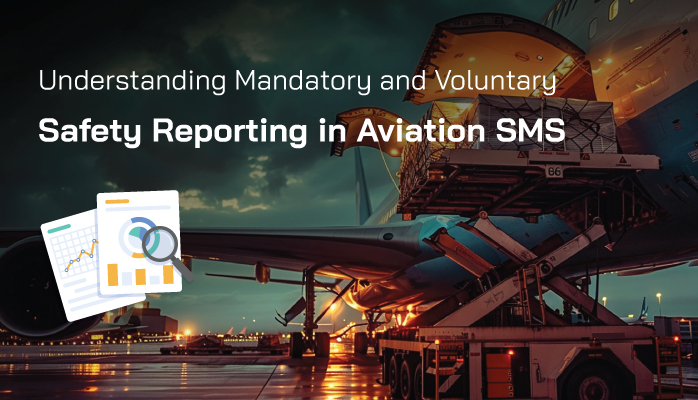What Are Mandatory and Voluntary Safety Reporting Policies

Mandatory and voluntary safety reporting policies are an extremely important part of providing guidance for safety reporting in aviation safety management systems (SMS). Yet, we rarely see these policies published and communicated in aviation SMS implementations.
A mandatory and voluntary reporting policy (or policies) outline what types of safety issues employees:
- MUST report as soon as they are identified; and
- CAN report, but are not obligated to do so, as they are identified.
Related Aviation Safety Reporting Articles
- What Is Missing Most in Aviation Safety Reporting Systems?
- 5 Simple Tips to Improve Aviation Safety Reporting Cultures
- How to Develop a Hazard Reporting System in Aviation SMS [With Free Checklist]
Purpose of Safety Reporting Policies
Each safety reporting policy should be simple and straightforward — written so employees are able to easily understand the message. Remember, the purpose of a reporting policy is to:
- Provide guidance to employees;
- Educate employees as to management's expectations;
- Manage employee expectations during the risk management process; and
- Build a positive safety reporting culture.
Creating a mandatory vs voluntary safety reporting policy simply involves:
- Writing several sentences on what the policy is, making sure to define what mandatory and voluntary reporting is;
- Listing all of the types of mandatory safety issues employees must report, such as:
- Runway incursion;
- Collision-related occurrences;
- Aircraft structural defects;
- Tools missing; and
- Pilot fatigue
- Listing common issues that you encourage employees to report, but don’t have to, such as:
- Security team member fatigue
- Debris in walkway
Again, this policy is best written primarily as a list. The idea is that employees can consult it often and skim the list to find the safety issue they are wondering whether or not to report.
How to Train Employees on Mandatory vs Voluntary Reporting

Training employees on mandatory vs voluntary safety reporting processes MUST happen. If it doesn’t, how can you expect employees to know what to report?
Here are some good tips for training employees on this policy:
- Include it in employee initial SMS induction training;
- Include it in employee recurrent SMS training;
- Distribute copies of the list throughout your operational environment;
- Provide digital copy employees can keep on their cell phones, computers, tablets, etc.;
- Reference the list in your safety newsletters;
- Thank employees when they report mandatory safety issues - calling attention to the fact that they reported a mandatory safety issue; and
- Thank employees when they report voluntary safety issues - calling attention to the fact that they proactively reported a voluntary safety issue.
Over time, employees will naturally gain an understanding of what types of safety issues they MUST and CAN report.
Related Aviation Safety Reporting Articles
- How Safety Managers Hurt Safety Reporting Performance - Aviation SMS
- How Confidential Aviation Safety Reporting Systems Offer Assurance to Employees
- Essential KPIs for Poor Hazard Reporting Cultures in Aviation SMS - With Free KPI Resources
What Kinds of Issues Should Be Mandatory to Report
Safety issues that employees must report are what you would call “non-negotiable." Frankly, it’s difficult to simply say what you should and shouldn’t require employees to report.
Why? Because your mandatory vs voluntary reporting policy is specific to your organization. There are some good guidelines to follow though. Types of reportable safety issues should be mandatory if it:
- Is required by the civil aviation authority (CAA);
- Relate to one of your aviation key performance indicators;
- Has been identified as a high-risk safety issue within the organization;
- Is a high severity issue involving plant or equipment;
- Relates to a recent trend that management wishes to closely monitor;
- It is pertinent to other key metrics you use to monitor safety performance;
- It involves human injuries; and
- It’s just a type of issue important to management.
How to Encourage Mandatory Safety Reporting
The implication of some of the above points is that your list of mandatory safety issues to report will change as the environment changes. This is good. Why?
- Mandatory safety reporting is the baseline of your safety reporting culture;
- It should have additions over time;
- It should be pruned over time – having changes will:
- Keep employees' attention (keep them “on their toes”)
- Give you an excuse to retrain employees regarding your safety reporting policy
- Demonstrate to employees that management values the safety reporting process
- If your list is too long it won’t be usable, so keep it reasonable;
- Reference the list at every possible opportunity – see the How to Train Employees on Mandatory Reporting section; and
- Have unique safety reporting forms for important types of mandatory safety issues.
These simple best practices will help you build a safety reporting culture baseline.
Related Aviation Safety Reporting Culture Articles
- Indicators of Good Hazard Reporting Culture
- How to Develop Healthy Safety Reporting Cultures in Aviation SMS
- How to Monitor Aviation Safety Reporting Culture Using Safety Charts
Why Voluntary Safety Reporting Matters
Voluntary safety reporting is important for a similar reason that mandatory reporting is:
- Mandatory reporting is your safety reporting culture baseline – in other words:
- Do you have the basic culture you need for a reasonable safety reporting system?
- Voluntary safety reporting reflects how mature your safety reporting culture is – in other words:
- How advanced are your safety reporting practices?

Improving voluntary safety reporting activities is something you should focus on after employees are clearly reporting mandatory safety issues most or all of the time. These voluntary safety reports are not to be discounted, as they add value in:
- Continuously improving operational processes;
- Keeping employees engaged in the SMS' proactive risk management activities;
- Alerting management of potential opportunities that extend beyond safety.
Minor safety issues and close calls become increasingly valuable when one considers the 1:600 rule. This Heinrich incident triangle (pictured above) illustrates that for every major accident, there will be over 600 close calls and minor incidents to "practice" refining your operational processes before the organization suffers from the major event. These minor incidents typically make up those close calls and minor incidents.
As time passes by and you are collecting your 600 minor safety issues, your SMS will have reviewed most hazards that your operations interact with. One caveat to the above-mentioned "600 minor safety issues" is that you may have your major accident on the first safety issue or the 300th or the 600th. Please don't believe you have 600 chances to get it right. You may be unfortunate and experience your major accident before you've had time to reduce hazards' associated risk to as low as reasonably practical (ALARP).
The point is: All safety issues should be reported. Let management decide what to do with the safety reports. Employees are not experts in hazard and risk management. Get employees to report everything and the safety team and the hazards' process owners can determine whether additional mitigation strategies are warranted.
What Kinds of Safety Issues Should Be Voluntary to Report
Which voluntary safety issues should be included in your list? Well, like mandatory safety issues, it’s hard to give you specific items because you have your unique needs.
But it’s as easy as this:
- If it’s not mandatory, it’s voluntary;
- Put your top 15 types of safety issues that are not mandatory on your voluntary list as examples; and
- Make it clear that you encourage ALL safety issues to be reported, no matter how minor (this is a best practice).
The Heinrich incident triangle provides an excellent example to communicate to all employees why reporting all safety issues is a good practice.
Related Aviation Safety Reporting Articles
- How to Analyze Safety Reporting Performance in Aviation SMS Using Charts
- How to Get Employees Participating in Safety Reporting - Aviation SMS
- What Are Most Important Things to Know About Hazard Reporting in SMS
How to Encourage Voluntary Safety Reporting
Encouraging voluntary safety reporting is part of a larger conversation about how to build a safety reporting culture.
Some good practices are:
- Make reporting safety issues as easy as possible;
- Make reporting voluntary issues as quick as possible;
- Train employees on the importance of reporting safety issues- how does it benefit them;
- Thank employees personally whenever they report;
- Practice due diligence managing safety issues on time; and
- Update employees who reported safety issues as you take action on their issues.
Final Thoughts on Safety Reporting in Aviation SMS
If you are reading this article, your safety reporting culture is probably not as performant as you would like. Approximately 75% of aviation service providers have substandard safety reporting cultures. This is based on a "best-in-class" safety reporting metric of "one safety report for every ten employees per month."
To keep the safety reporting culture strong, you will need to continually:
- Educate employees as to the purpose of their vigilance;
- Inform employees of results based on their inputs;
- Protect employees from management reprisals for self-reporting; and
- Reduce friction to the safety reporting process.
Friction to safety reporting can come from management's attitudes toward the SMS implementation or from the safety reporting process, which includes tools. When employees have to work too hard to report simple safety concerns, guess what? They won't do it!
Safety reporting processes in aviation SMS implementations should be varied and very user-friendly. By varied, I am referring to the context or situation the employee finds himself in. What tools does the employee have to report safety concerns? Are these tools convenient for employees to easily report safety concerns based on their location and work assignments? Possible approaches include:
- Email reporting;
- Paper forms;
- Verbal;
- Web-based safety reporting system;
- Offline reporting (low-speed or no Internet settings); and
- Mobile apps.
Is your safety reporting system easy to use? Is it integrated with your SMS risk management system?
These following videos highlight a Web-based safety reporting system. What features would benefit your company? Since 2007, SMS Pro has provided a safety reporting system that is considered one of the best in the industry. Check it out!
Last updated in September 2024.








